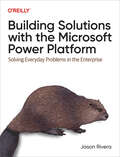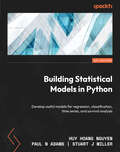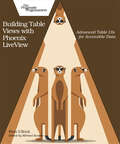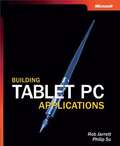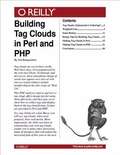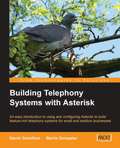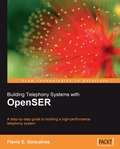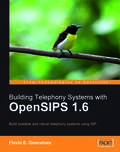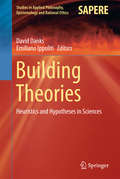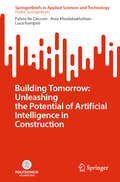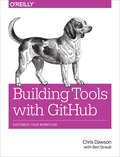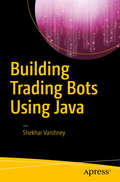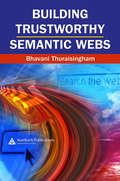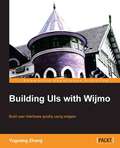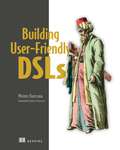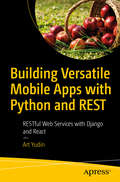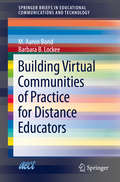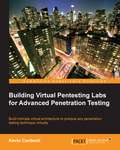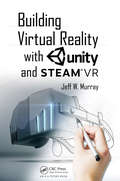- Table View
- List View
Building Solutions with the Microsoft Power Platform: Solving Everyday Problems in the Enterprise
by Jason RiveraWith the accelerating speed of business and the increasing dependence on technology, companies today are significantly changing the way they build in-house business solutions. Many now use low-code and no code technologies to help them deal with specific issues, but that's just the beginning. With this practical guide, power users and developers will discover ways to resolve everyday challenges by building end-to-end solutions with the Microsoft Power Platform.Author Jason Rivera, who specializes in SharePoint and the Microsoft 365 solution architecture, provides a comprehensive overview of how to use the Power Platform to build end-to-end solutions that address tactical business needs. By learning key components of the platform, including Power Apps, Power Automate, and Power BI, you'll be able to build low-code and no code applications, automate repeatable business processes, and create interactive reports from available data.Learn how the Power Platform apps work togetherIncorporate AI into the Power Platform without extensive ML or AI knowledgeCreate end-to-end solutions to solve tactical business needs, including data collection, process automation, and reportingBuild AI-based solutions using Power Virtual Agents and AI Builder
Building Statistical Models in Python: Develop useful models for regression, classification, time series, and survival analysis
by Huy Hoang Nguyen Paul N Adams Stuart J MillerMake data-driven, informed decisions and enhance your statistical expertise in Python by turning raw data into meaningful insights Purchase of the print or Kindle book includes a free PDF eBookKey FeaturesGain expertise in identifying and modeling patterns that generate successExplore the concepts with Python using important libraries such as stats modelsLearn how to build models on real-world data sets and find solutions to practical challengesBook DescriptionThe ability to proficiently perform statistical modeling is a fundamental skill for data scientists and essential for businesses reliant on data insights. Building Statistical Models with Python is a comprehensive guide that will empower you to leverage mathematical and statistical principles in data assessment, understanding, and inference generation. This book not only equips you with skills to navigate the complexities of statistical modeling, but also provides practical guidance for immediate implementation through illustrative examples. Through emphasis on application and code examples, you’ll understand the concepts while gaining hands-on experience. With the help of Python and its essential libraries, you’ll explore key statistical models, including hypothesis testing, regression, time series analysis, classification, and more. By the end of this book, you’ll gain fluency in statistical modeling while harnessing the full potential of Python's rich ecosystem for data analysis.What you will learnExplore the use of statistics to make decisions under uncertaintyAnswer questions about data using hypothesis testsUnderstand the difference between regression and classification modelsBuild models with stats models in PythonAnalyze time series data and provide forecastsDiscover Survival Analysis and the problems it can solveWho this book is forIf you are looking to get started with building statistical models for your data sets, this book is for you! Building Statistical Models in Python bridges the gap between statistical theory and practical application of Python. Since you’ll take a comprehensive journey through theory and application, no previous knowledge of statistics is required, but some experience with Python will be useful.
Building Table Views with Phoenix LiveView
by Peter UllrichAs a web developer, you have to build tables. Lots and lots of tables. With table UIs making up such a significant part of your daily work, you need to know how to build the right table for the task, with all the needed features. Building a simple table is easy, but tables only become really useful with advanced features like pagination, sorting, and filtering. That’s where building a table can quickly become complicated. This book shows you how to implement advanced table features in a clean and reusable way. You’ll build fast and interactive table UIs by leveraging Phoenix LiveView. Make vast amounts of data manageable with common but complex features like pagination, sorting, filtering, and inifinity scrolling. Use SOLID coding principles to make your queries reusable with query composition. Compartmentalize your UI with LiveComponents and learn how to handle user input securely with schemaless changesets. Share your view onto the data painlessly by storing your search parameters in the URL. Data is one of the most valuable assets of your business, but you cannot unlock its potential if you don’t know how to make it accessible. This book shows you how to deliver that data to your users’ fingertips quickly. ","Data is at the core of every business, but it is useless if nobody can access and analyze it. Learn how to generate business value by making your data accessible with advanced table UIs. This definitive guide teaches you how to bring your data to the fingertips of nontechnical users with advanced features like pagination, sorting, filtering, and infinity scrolling. Build reactive and reuseable table components by leveraging Phoenix LiveView, schemaless changesets, and Ecto query composition. Table UIs are the bread and butter for every web developer, so it is time to learn how to build them right.
Building Tablet PC Applications
by Rob Jarrett Phillip SuMany pen-based software platforms have been introduced in the last decade, but only recently has the introduction of faster processors and hardware enabled mainstream introduction of tablet-sized pen-based PCs. This book tackles the challenge of writing compelling Tablet PC software on two fronts. First, it distills decades of usability research into pen-based computing to present an authoritative discussion of the optimal design of pen-based user interfaces. Second, it provides an in-depth exposition of the Tablet PC Ink SDK, complete with tips and tricks on how developers can produce the most powerful and natural "ink-aware" applications. Distills decades of usability research into pen-based software to present an authoritative discussion of the optimal design of pen-based user interfaces Provides an in-depth exposition of the TabletPC Ink SDK, complete with tips and tricks on how developers can produce the most powerful and natural pen-based, "ink-aware" applications Co-written by the lead software developer on the Microsoft TabletPC team
Building Tag Clouds in Perl and PHP
by Jim BumgardnerTag clouds are everywhere on the web these days. First popularized by the web sites Flickr, Technorati, and del.icio.us, these amorphous clumps of words now appear on a slew of web sites as visual evidence of their membership in the elite corps of "Web 2.0." This PDF analyzes what is and isn't a tag cloud, offers design tips for using them effectively, and then goes on to show how to collect tags and display them in the tag cloud format. Scripts are provided in Perl and PHP. Yes, some have said tag clouds are a fad. But as you will see, tag clouds, when used properly, have real merits. More importantly, the skills you learn in making your own tag clouds enable you to make other interesting kinds of interfaces that will outlast the mercurial fads of this year or the next.
Building Telegram Bots: Develop Bots in 12 Programming Languages using the Telegram Bot API
by Nicolas ModrzykLearn about bot programming, using all the latest and greatest programming languages, including Python, Go, and Clojure, so you can feel at ease writing your Telegram bot in a way that suits you.This book shows how you can use bots for just about everything: they connect, they respond, they enhance your job search chances, they do technical research for you, they remind you about your last train, they tell the difference between a horse and a zebra, they can tell jokes, and they can cheer you up in the middle of the night. Bots used to be hard to set up and enhance, but with the help of Building Telegram Bots you’ll see how the Telegram platform is now making bot creation easier than ever. You will begin by writing a simple bot at the start and then gradually build upon it. The simple yet effective Telegram Bot API makes it very easy to develop bots in a number of programming languages. Languages featured in the book include Node.js, Java, Rust, and Elixir. This book encourages you to not only learn the basic process of creating a bot but also lets you spend time exploring its possibilities. By the end of the book you will be able create your own Telegram Bot with the programming language of your choice. What You Will LearnCarry out simple bot design and deployment in various programming languages including Ruby, D, Crystal, Nim, and C++Create engaging bot interactions with your usersAdd payments and media capabilities to your botsMaster programming language abstractionWho This Book Is ForEngineers who want to get things done. People who are curious. Programming beginners. Advanced engineers with little time to do research.
Building Telephony Systems With Asterisk
by Barrie Dempster David GomillionThis book is aimed at anyone who is interested in building a powerful telephony system using the free and open source application, Asterisk, without spending many thousands of dollars buying a commercial and often less flexible system. This book is suitable for the novice and those new to Asterisk and telephony. Telephony or Linux experience will be helpful, but not required.
Building Telephony Systems with OpenSER
by Flavio E. GoncalvesThis book is a well illustrated, step-by-step guide to building a SIP based network using OpenSER. This book is for readers who want to understand how to build a SIP provider from scratch using OpenSER. Telephony and Linux experience will be helpful but is not essential. Readers need not have prior knowledge of OpenSER.
Building Telephony Systems with OpenSIPS - Second Edition
by Flavio E. Goncalves Bogdan-Andrei IancuBuild high-speed and highly scalable telephony systems using OpenSIPS About This Book * Install and configure OpenSIPS to authenticate, route, bill, and monitor VoIP calls * Gain a competitive edge using the most scalable VoIP technology * Discover the latest features of OpenSIPS with practical examples and case studies Who This Book Is For If you want to understand how to build a SIP provider from scratch using OpenSIPS, then this book is ideal for you. It is beneficial for VoIP providers, large enterprises, and universities. This book will also help readers who were using OpenSER but are now confused with the new OpenSIPS. Telephony and Linux experience will be helpful to get the most out of this book but is not essential. Prior knowledge of OpenSIPS is not assumed. What You Will Learn * Learn to prepare and configure a Linux system for OpenSIPS * Familiarise yourself with the installation and configuration of OpenSIPS * Understand how to set a domain and create users/extensions * Configure SIP endpoints and make calls between them * Make calls to and from the PSTN and create access control lists to authorize calls * Install a graphical user interface to simplify the task of provisioning user and system information * Implement an effective billing system with OpenSIPS * Monitor and troubleshoot OpenSIPS to keep it running smoothly In Detail OpenSIPS is a multifunctional, multipurpose signalling SIP server. SIP (Session Initiation Protocol) is nowadays the most important VoIP protocol and OpenSIPS is the open source leader in VoIP platforms based on SIP. OpenSIPS is used to set up SIP Proxy servers. The purpose of these servers is to receive, examine, and classify SIP requests. The whole telecommunication industry is changing to an IP environment, and telephony as we know it today will completely change in less than ten years. SIP is the protocol leading this disruptive revolution and it is one of the main protocols on next generation networks. While a VoIP provider is not the only kind of SIP infrastructure created using OpenSIPS, it is certainly one of the most difficult to implement. This book will give you a competitive edge by helping you to create a SIP infrastructure capable of handling tens of thousands of subscribers. Starting with an introduction to SIP and OpenSIPS, you will begin by installing and configuring OpenSIPS. You will be introduced to OpenSIPS Scripting language and OpenSIPS Routing concepts, followed by comprehensive coverage of Subscriber Management. Next, you will learn to install, configure, and customize the OpenSIPS control panel and explore dialplans and routing. You will discover how to manage the dialog module, accounting, NATTraversal, and other new SIP services. The final chapters of the book are dedicated to troubleshooting tools, SIP security, and advanced scenarios including TCP/TLS support, load balancing, asynchronous processing, and more. A fictional VoIP provider is used to explain OpenSIPS and by the end of the book, you will have a simple but complete system to run a VoIP provider. Style and approach This book is a step-by-step guide based on the example of a VoIP provider. You will start with OpenSIPS installation and gradually, your knowledge depth will increase.
Building Telephony Systems with OpenSIPS 1.6
by Flavio E. GoncalvesThis is a practical, hands-on book based around a fictitious case study VoIP Provider that you will build on a development server using OpenSIPS 1.6. The case study grows chapter by chapter, from installing your local development server, right up to the finished VoIP provider. This book is for readers who want to understand how to build a SIP provider from scratch using OpenSIPS. It is suitable for VoIP providers, large enterprises, and universities. Telephony and Linux experience will be helpful but is not essential. Readers need not have prior knowledge of OpenSIPS. This book will also help readers who were using OpenSER but are now confused with the new OpenSIPS.
Building Theories: Heuristics and Hypotheses in Sciences (Studies in Applied Philosophy, Epistemology and Rational Ethics #41)
by Emiliano Ippoliti David DanksThis book explores new findings on the long-neglected topic of theory construction and discovery, and challenges the orthodox, current division of scientific development into discrete stages: the stage of generation of new hypotheses; the stage of collection of relevant data; the stage of justification of possible theories; and the final stage of selection from among equally confirmed theories. The chapters, written by leading researchers, offer an interdisciplinary perspective on various aspects of the processes by which theories rationally should, and descriptively are, built. They address issues such as the role of problem-solving and heuristic reasoning in theory-building; how inferences and models shape the pursuit of scientific knowledge; the relation between problem-solving and scientific discovery; the relative values of the syntactic, semantic, and pragmatic view of theories in understanding theory construction; and the relation between ampliative inferences, heuristic reasoning, and models as a means for building new theories and knowledge. Through detailed arguments and examinations, the volume collectively challenges the orthodox view's main tenets by characterizing the ways in which the different "stages" are logically, temporally, and psychologically intertwined. As a group, the chapters provide several attempts to answer long-standing questions about the possibility of a unified conceptual framework for building theories and formulating hypotheses.
Building Tomorrow: Unleashing the Potential of Artificial Intelligence in Construction (SpringerBriefs in Applied Sciences and Technology)
by Fulvio Re Cecconi Ania Khodabakhshian Luca RampiniThis book explores the transformative impact of artificial intelligence (AI) on the construction industry, examining its readiness for widespread integration and its potential to reshape various facets of the construction lifecycle. It introduces the concept of a readiness metric tailored to the construction sector, providing a comprehensive framework for assessing and improving AI adoption. The narrative then shifts to the early stages of projects, highlighting the role of AI in promoting sustainability. From leveraging open data for data-driven decisions to using machine learning for strategic decisions in retrofitting and decarbonising the built environment, the book investigates how AI can be a catalyst for positive change in the construction process. It then explores the integration of AI into project and risk management, unlocking the potential of advanced analytics and predictive modelling to streamline processes and improve decision-making, and the application of AI in asset and facility management, highlighting how intelligent technologies can optimise the lifecycle of built assets. Examining the responsible use of AI tools, the book addresses ethical challenges and outlines guidelines for the conscientious and equitable integration of AI into the construction ecosystem. Overall, it serves as a comprehensive guide for industry professionals, researchers, and policymakers, providing insights into the current landscape, the potential of AI, and the ethical considerations necessary for responsible implementation.
Building Tools with GitHub: Customize Your Workflow
by Chris Dawson Ben StraubFor your next project on GitHub, take advantage of the service’s powerful API to meet your unique development requirements. This practical guide shows you how to build your own software tools for customizing the GitHub workflow. Each hands-on chapter is a compelling story that walks you through the tradeoffs and considerations for building applications on top of various GitHub technologies.If you’re an experienced programmer familiar with GitHub, you’ll learn how to build tools with the GitHub API and related open source technologies such as Jekyll (site builder), Hubot (NodeJS chat robot), and Gollum (wiki).Build a simple Ruby server with Gist API command-line tools and Ruby’s "Octokit" API clientUse the Gollum command-line tool to build an image management applicationBuild a GUI tool to search GitHub with PythonDocument interactions between third-party tools and your codeUse Jekyll to create a fully-featured blog from material in your GitHub repositoryCreate an Android mobile application that reads and writes information into a Jekyll repositoryHost an entire single-page JavaScript application on GitHubUse Hubot to automate pull request reviews
Building Trading Bots Using Java
by Shekhar VarshneyBuild an automated currency trading bot from scratch with java. In this book, you will learn about the nitty-gritty of automated trading and have a closer look at Java, the Spring Framework, event-driven programming, and other open source APIs, notably Google's Guava API. And of course, development will all be test-driven with unit testing coverage. The central theme of Building Trading Bots Using Java is to create a framework that can facilitate automated trading on most of the brokerage platforms, with minimum changes. At the end of the journey, you will have a working trading bot, with a sample implementation using the OANDA REST API, which is free to use. What You'll Learn Find out about trading bots Discover the details of tradeable instruments and apply bots to them Track and use market data events Place orders and trades Work with trade/order and account events Who This Book Is For Experienced programmers new to bots and other algorithmic trading and finance techniques.
Building Trust in the Generative Artificial Intelligence Era: Technology Challenges and Innovations (Routledge Studies in Trust Research)
by Jerzy Gołuchowski Joanna Paliszkiewicz Kuanchin Chen Magdalena Mądra-SawickaIn an era where generative artificial intelligence (AI) is reshaping industries and daily life, trust has become a cornerstone for its successful adoption and application. Building Trust in the Generative Artificial Intelligence Era: Technology Challenges and Innovations explores how trust can be built, maintained, and evaluated in a world increasingly reliant on AI technologies. Designed to be accessible to a broad audience, thi book blends theoretical insights with practical approaches, offering readers a comprehensive understanding of the topic.This book is divided into three parts. The first part examines the foundations of trust in generative AI, highlighting trends and ethical challenges such as "greenwashing" and remote work dynamics. The second part provides actionable frameworks and tools for assessing and enhancing trust, focusing on topics like cybersecurity, transparency, and explainability. The final section presents global case studies exploring university students' perceptions of ChatGPT, generative AI's applications in European agriculture, and its transformative impact on financial systems.By addressing both the opportunities and risks of generative AI, this book delivers groundbreaking insights for academics, professionals, and policymakers worldwide. It emphasizes practical solutions, ensuring readers gain the knowledge needed to navigate the evolving technological landscape and foster trust in transformative AI systems.
Building Trustworthy Semantic Webs
by Bhavani ThuraisinghamSemantic Webs promise to revolutionize the way computers find and integrate data over the internet. They will allow Web agents to share and reuse data across applications, enterprises, and community boundaries. However, this improved accessibility poses a greater threat of unauthorized access, which could lead to the malicious corruption of informa
Building UIs with Wijmo
by Yuguang ZhangWritten with an example-based approach, Building UIs with Wijmo leads you step by step through the implementation and customization of each library component and its associated resources. Reference tables of each configuration option, method, and event for each component are provided, alongside detailed explanations of how each widget is used.Building UIs with Wijmo is targeted at readers who are familiar with HTML, CSS, JavaScript, and jQuery, and have a basic understanding of web development. Although knowledge of jQuery UI is not mandatory, it would be a bonus as it is quite similar to Wijmo. Only the last chapter of the book on extending Wijmo requires advanced CSS and JavaScript knowledge.
Building User-Friendly DSLs
by Meinte BoersmaCraft domain-specific languages that empower experts to create software themselves.Domain-specific languages put business experts at the heart of software development. These purpose-built tools let your clients write down their business knowledge and have it automatically translated into working software—no dev time required. They seamlessly bridge the knowledge gap between programmers and subject experts, enabling better communication and freeing you from time-consuming code adjustments. Inside Building User-Friendly DSLs you&’ll learn how to: • Build a complete Domain IDE for a car rental company • Implement a projectional editor for your DSL • Implement content assist, type systems, expressions, and versioning language aspects • Evaluate business rules • Work with Abstract Syntax Trees • Reduce notated DSL content in concrete syntax into abstract syntax Building User-Friendly DSLs takes you on a carefully-planned journey through everything you need to create your own DSLs. It focuses on building DSLs that are easy for busy business experts to learn and master. By working through a detailed example of a car rental company, you'll see how to create a custom DSL with a modern and intuitive UI that can replace tedious coding activities. About the technology Here&’s the central problem of software development: business users know what they need their apps to do, but they don&’t know how to write the code themselves. As a developer, this means you spend a lot of time learning the same domain-specific details your user already knows. Now there&’s a way to bridge this gap! You can create a Domain-Specific Language (DSL) that empowers non-technical business users to create and customize their own applications without writing any code. About the book Building User-Friendly DSLs teaches you how to create a complete domain-specific language that looks and works like a web application. These easy-to-use DSLs put the power to create custom software into the hands of business domain experts. As you go, you&’ll cover all the essentials, from establishing structure and syntax of your DSL to implementing a user-friendly interface. What's inside • Implement a projectional editor for your DSL • Work with Abstract Syntax Trees • Evaluate business rules About the reader For developers with JavaScript and web development experience. About the author Meinte Boersma is a senior developer and an evangelist of model-driven software development and DSLs. Table of Contents 1 What is a domain-specific language? 2 Representing DSL content as structured data 3 Working with ASTs in code 4 Projecting the AST 5 Editing values in the projection 6 Editing objects in the projection 7 Implementing persistence and transportation of ASTs 8 Generating code from the AST 9 Preventing things from blowing up 10 Managing change 11 Implementing expressions: Binary operations 12 Implementing expressions: Order of operations 13 Implementing a type system 14 Implementing business rules 15 Some topics we didn&’t cover
Building VMware Software-Defined Data Centers
by Valentin HamburgerMake the most of software-defined data centers with revolutionary VMware technologies About This Book • Learn how you can automate your data center operations and deploy and manage applications and services across your public, private, and hybrid infrastructure in minutes • Drive great business results with cost-effective solutions without compromising on ease, security, and controls • Transform your business processes and operations in a way that delivers any application, anywhere, with complete peace of mind Who This Book Is For If you are an IT professional or VMware administrator who virtualizes data centers and IT infrastructures, this book is for you. Developers and DevOps engineers who deploy applications and services would also find this book useful. Data center architects and those at the CXO level who make decisions will appreciate the value in the content. What You Will Learn • Understand and optimize end-to-end processes in your data center • Translate IT processes and business needs into a technical design • Apply and create vRO workflow automation functionalities to services • Deploy NSX in a virtual environment • Technically accomplish DevOps offerings • Set up and use vROPs to master the SDDC resource demands • Troubleshoot all the components of SDDC In Detail VMware offers the industry-leading software-defined data center (SDDC) architecture that combines compute, storage, networking, and management offerings into a single unified platform. This book uses the most up-to-date, cutting-edge VMware products to help you deliver a complete unified hybrid cloud experience within your infrastructure. It will help you build a unified hybrid cloud based on SDDC architecture and practices to deliver a fully virtualized infrastructure with cost-effective IT outcomes. In the process, you will use some of the most advanced VMware products such as VSphere, VCloud, and NSX. You will learn how to use vSphere virtualization in a software-defined approach, which will help you to achieve a fully-virtualized infrastructure and to extend this infrastructure for compute, network, and storage-related data center services. You will also learn how to use EVO:RAIL. Next, you will see how to provision applications and IT services on private clouds or IaaS with seamless accessibility and mobility across the hybrid environment. This book will ensure you develop an SDDC approach for your datacenter that fulfills your organization's needs and tremendously boosts your agility and flexibility. It will also teach you how to draft, design, and deploy toolsets and software to automate your datacenter and speed up IT delivery to meet your lines of businesses demands. At the end, you will build unified hybrid clouds that dramatically boost your IT outcomes. Style and approach With the ever-changing nature of businesses and enterprises, having the capability to navigate through the complexities is of utmost importance. This book takes an approach that combines industry expertise with revolutionary VMware products to deliver a complete SDDC experience through practical examples and techniques, with proven cost-effective benefits.
Building Value through Marketing: A Step-by-Step Guide
by Philip SugaiBuilding Value through Marketing provides a hands-on guide to understanding and building compelling marketing plans that create value, not only in profit terms but also for customers and stakeholders. Working step-by-step through strategy development, this book empowers those responsible for creating or managing new products or services to have the right mindset, understand the most important marketing tools that they can use and apply these to create unprecedented levels of value. Founded on the principle of Service Dominant Logic, the book is organized into three key sections: "The Value Mindset," "The 12 Building Blocks of Value," and "Value-Focused Marketing in Action," which walk through the process of value-focused product and service development. The strategies and tools put forward have been tested successfully across multiple industries and countries and are grounded in academic theory, emphasized by real-life case studies throughout. Readers will gain the ability to align their marketing scholarship and practices with the current definition of why a business exists and the role that marketing plays within these business practices. This is essential reading for those studying Marketing Planning and Strategy at Advanced Undergraduate, Postgraduate and MBA levels. Its uniquely applied approach also makes it an excellent guide for marketing practitioners and institutions offering professional qualifications.
Building Versatile Mobile Apps with Python and REST: RESTful Web Services with Django and React
by Art YudinDevelop versatile iOS apps using Python with RESTful web services. This book will show you how to blend Django, a high-level Python Web framework, with Django REST, the powerful, feature-filled extension, to build iOS mobile apps.Using easy-to-follow examples, you'll begin by building a simple app using the RESTful Web API and iOS. You'll begin by using traditional Django to create models and connect your App to the database. You'll then see how to serialize your data and create the RESTful API. The second part of the book introduces Xcode, a programming environment to develop iOS apps. Using Swift, the programming language for iOS, you'll design the actual app. Once you have your back-end in Django and a front-end in Swift, you'll connect them using our RESTful API. You'll be able to log in, browse places of interest, and rate them and leave comments. Guided step-by-step instructions, Building Versatile Mobile Apps with Python and REST will demonstrate how easy it is to use Python to develop iOS applications. What You'll LearnBuild Create-Read-Update-Delete functionality using RESTful Web Services Incorporate marketing into the design of iOS apps to stand out in the App Store Deploy your app to a live server and add it to Apple app store Who This Book Is ForAspiring programmers who want to develop modern RESTful Web Services and design the front-end for iOS. Developers who want to combine the most powerful and popular back-end technology—Python—and monetize it with a popular iOS platform in Apple App Store.
Building Virtual Communities of Practice for Distance Educators (SpringerBriefs in Educational Communications and Technology #1)
by M. Aaron Bond Barbara B. LockeeAs colleges, universities and other learning institutions explore teaching and learning through online environments, online communities of practice may provide solutions to organizational and professional development needs. The purpose of this book is to develop a set of guidelines for creating a virtual community of practice for faculty teaching at a distance that can easily be implemented by faculty development professionals. Designing a virtual community of practice can be operationalized using the ADDIE model to guide the process. Based on an instructional systems design process, the ADDIE model emphasizes the five core elements of the instructional systems design process: analyze, design, develop, implement and evaluate; often it serves as a project management tool or to provide a visual aid for organization of relevant tasks.
Building Virtual Pentesting Labs for Advanced Penetration Testing
by Kevin CardwellWritten in an easy-to-follow approach using hands-on examples, this book helps you create virtual environments for advanced penetration testing, enabling you to build a multi-layered architecture to include firewalls, IDS/IPS, web application firewalls, and endpoint protection, which is essential in the penetration testing world.If you are a penetration tester, security consultant, security test engineer, or analyst who wants to practice and perfect penetration testing skills by building virtual pentesting labs in varying industry scenarios, this is the book for you. This book is ideal if you want to build and enhance your existing pentesting methods and skills. Basic knowledge of network security features is expected along with web application testing experience.
Building Virtual Pentesting Labs for Advanced Penetration Testing - Second Edition
by Kevin CardwellLearn how to build complex virtual architectures that allow you to perform virtually any required testing methodology and perfect it About This Book * Explore and build intricate architectures that allow you to emulate an enterprise network * Test and enhance your security skills against complex and hardened virtual architecture * Learn methods to bypass common enterprise defenses and leverage them to test the most secure environments. Who This Book Is For While the book targets advanced penetration testing, the process is systematic and as such will provide even beginners with a solid methodology and approach to testing. You are expected to have network and security knowledge. The book is intended for anyone who wants to build and enhance their existing professional security and penetration testing methods and skills. What You Will Learn * Learning proven security testing and penetration testing techniques * Building multi-layered complex architectures to test the latest network designs * Applying a professional testing methodology * Determining whether there are filters between you and the target and how to penetrate them * Deploying and finding weaknesses in common firewall architectures. * Learning advanced techniques to deploy against hardened environments * Learning methods to circumvent endpoint protection controls In Detail Security flaws and new hacking techniques emerge overnight - security professionals need to make sure they always have a way to keep . With this practical guide, learn how to build your own virtual pentesting lab environments to practice and develop your security skills. Create challenging environments to test your abilities, and overcome them with proven processes and methodologies used by global penetration testing teams. Get to grips with the techniques needed to build complete virtual machines perfect for pentest training. Construct and attack layered architectures, and plan specific attacks based on the platforms you're going up against. Find new vulnerabilities for different kinds of systems and networks, and what these mean for your clients. Driven by a proven penetration testing methodology that has trained thousands of testers, Building Virtual Labs for Advanced Penetration Testing, Second Edition will prepare you for participation in professional security teams. Style and approach The book is written in an easy-to-follow format that provides a step-by-step, process-centric approach. Additionally, there are numerous hands-on examples and additional references for readers who might want to learn even more. The process developed throughout the book has been used to train and build teams all around the world as professional security and penetration testers.
Building Virtual Reality with Unity and Steam VR
by Jeff W MurrayThe golden age of virtual reality is here; take the first step into V.R. programming and development with Jeff W. MurrayBuilding Virtual Reality with Unity and SteamVR. Murray explores some of the topical issues surrounding virtual reality; including V.R. sickness, telepresence, performance issues and practical ways to diminish these detrimental effects to make a more comprehensive experience. Building Virtual Reality also grants readers a hands-on approach with the Unity game engine and programming. The example projects and sample C# code found in the text are compatible with all SteamVR supported virtual reality head mounted displays that are currently available. This text is the essential survival guide to VR and VR development for any reader. Author Bio: Jeff W. Murray has written two books: Game Development for iOS with Unity3D, C# Game Programming Cookbook for Unity3D, both published by CRC Press. In his game development career spanning over 14 years, he has worked with some of the world Murray Key features: Discusses some of the key issues facing virtual reality and provides helpful tips for making better V.R. experiences. Develop V.R. applications with practical examples geared to work with both the Oculus Rift and HTC Vive, as well as open source virtual reality (OSVR) headsets like the HDK. Find out how to build both standing and seated experiences. Tips on optimizing performance with the Unity Profilers. Explore examples specifically for HTC Vive Controllers and picking up and throwing physics objects, including haptic feedback. Discover how to build user interfaces for virtual reality, as well as discussing some best practices for V.R. based user interface design. Written by a games industry veteran who has been a V.R. developer since the first Oculus development kit.
